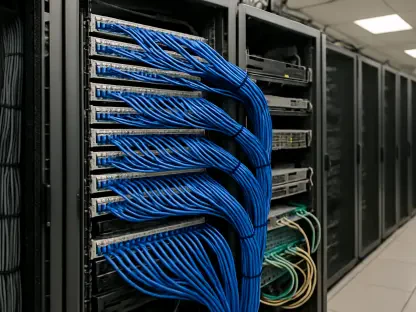The transformative integration of artificial intelligence (AI) into network management is revolutionizing how enterprises and service providers optimize and maintain their networks. Juniper Networks, at the forefront of this evolution, is developing AI-native networking solutions that promise enhanced efficiency, streamlined processes, and minimized disruptions. By leveraging AI, network operators can handle the increasing complexity and data volumes within modern networks more effectively, ultimately allowing businesses to divert their attention from operational distractions towards their core objectives.
As networks grow in complexity and the volume of data they must manage expands, manual network management is becoming increasingly impractical. The modern digital landscape demands a more advanced approach, and AI-driven technologies are stepping up to meet this challenge. By automating intricate network processes, AI offers a way to tackle this complexity efficiently. Neil McRae, chief network strategist at Juniper Networks, underscores the profound advantages of AI-native networking. According to McRae, AI can dynamically optimize network performance and resource utilization, analyzing enormous data sets to determine the most efficient routing paths. This technological leap is particularly invaluable for managing complex networks seamlessly, reducing the manual effort required and boosting overall efficiency.
The Promise of AI in Network Management
With AI-driven technologies creating unprecedented opportunities, network operations are witnessing a paradigm shift. AI’s ability to automate complex processes and analyze vast amounts of data transforms network management by mitigating the challenges associated with traditional, manual methods. This advancement goes beyond merely addressing operational hurdles, enabling businesses to focus more intently on their strategic goals instead of being bogged down by network maintenance issues.
Neil McRae from Juniper Networks highlights the essence of AI-native networking in optimizing network performance and resource utilization. AI meticulously analyzes expansive data sets to identify the most efficient routing paths, ensuring dynamic and seamless network performance. This capability is a game-changer, especially for large-scale, intricate network environments where manual management would be excessively laborious and prone to errors. The promise of AI in network management lies in its ability to intelligently navigate and streamline the complexities of modern networks, providing a robust, automated solution that enhances efficiency and reliability.
The integration of AI also means networks can adapt in real-time to changing conditions, optimizing traffic flow and ensuring consistent performance. By leveraging AI, businesses can achieve not only improved operational efficiency but also a higher degree of agility and responsiveness in their network operations. This dynamic approach is essential in today’s fast-paced digital world, where the ability to quickly adapt to new challenges and opportunities can provide a significant competitive edge.
Automation and Efficiency
One of the most compelling features of AI in network management is its ability to automate routine network housekeeping tasks. This automation plays a crucial role in reducing human error, which is a common cause of network issues. By ensuring that maintenance and configurations are performed consistently and accurately, AI-driven automation significantly enhances network reliability and performance. Automated processes minimize the likelihood of mistakes that could lead to network downtime or disruptions, thereby supporting more stable and uninterrupted business operations.
Juniper’s AI agent, Marvis, serves as a prime example of how automation can revolutionize network management. Marvis autonomously handles network performance optimization, freeing businesses from the need for manual oversight and allowing them to focus on their primary activities. This AI-driven agent not only optimizes network performance but also provides valuable insights and recommendations for further improvements. By leveraging Marvis, businesses can achieve a higher level of operational efficiency and productivity, ultimately enhancing their overall performance.
The benefits of automation extend beyond mere efficiency gains. By reducing the manual effort required to manage networks, businesses can reallocate their resources towards more strategic initiatives, driving growth and innovation. Furthermore, the consistent and accurate execution of network tasks by AI-driven automation leads to more reliable and resilient network performance, reducing the risk of costly outages and downtime. This enhanced reliability is essential in today’s highly competitive and digitally-driven business environment.
By integrating AI-powered automation into their network management practices, businesses can achieve significant cost savings and operational efficiencies. Automation reduces the need for manual intervention, enabling IT teams to focus on higher-value activities and strategic projects. As a result, businesses can enhance their competitiveness and agility, adapting more readily to changing market conditions and customer demands.
Swift Issue Resolution
One of the standout capabilities of AI in network management is its ability to swiftly identify and resolve network issues. This rapid resolution is critical for maintaining high levels of network reliability and performance, especially in complex network environments. Tools like Marvis and Paragon are designed to pinpoint problems within seconds, reducing the time and effort required to address network issues. Previously, this process could take hours and involve coordination among multiple stakeholders, leading to prolonged disruptions and downtime.
In software-defined wide-area networks (SD-WANs), the application of AI tools like Marvis and Paragon is particularly beneficial. These tools not only enhance overall network reliability but also contribute to a significant reduction in downtime by swiftly resolving issues. By leveraging AI, businesses can minimize disruptions to their operations and ensure a more seamless and uninterrupted user experience. This capability is essential in today’s fast-paced digital world, where even brief periods of downtime can have significant repercussions.
The ability to quickly identify and resolve network issues also enables businesses to maintain a higher level of service quality, enhancing customer satisfaction and loyalty. AI tools provide valuable insights into network performance, allowing businesses to proactively address potential issues before they escalate into major problems. This proactive approach is key to maintaining a competitive edge and ensuring the continued success and reliability of network operations.
Swift issue resolution through AI-driven tools also supports more efficient and effective network management. By minimizing the time and effort required to address network problems, businesses can allocate their resources to more strategic initiatives, driving growth and innovation. This enhanced efficiency and operational effectiveness are crucial in the highly competitive and rapidly evolving digital landscape.
Modernizing Network Infrastructures
Network modernization is a multifaceted endeavor that goes beyond just enhancing operational efficiency. It encompasses aspects such as monetization, security, sustainability, and automation, all of which are critical for meeting the demands of the modern digital landscape. Service providers are increasingly adopting network-as-a-service models, which enable them to create on-demand networks tailored to customer needs. This approach not only enhances customer satisfaction but also provides businesses with the flexibility to scale and adapt their networks in response to changing requirements.
AI plays a pivotal role in the ongoing efforts to modernize network infrastructures. One of the key contributions of AI in this context is its ability to optimize energy usage and provide visibility into energy consumption. By leveraging AI, businesses can achieve significant energy savings and enhance the sustainability of their network operations. This focus on sustainability is becoming increasingly important as businesses strive to reduce their environmental impact and meet growing regulatory and consumer expectations.
In addition to enhancing sustainability, AI-driven network modernization also supports improved security. AI can identify and respond to potential security threats more quickly and accurately than traditional methods, providing a higher level of protection for network infrastructures. By proactively addressing security challenges, businesses can safeguard their data and maintain the trust of their customers.
The adoption of AI-native solutions also plays a critical role in the broader digital transformation efforts of businesses. By modernizing their network infrastructures, businesses can unlock new opportunities for growth and innovation, staying ahead of the competition and better serving their customers. AI-driven network modernization is not just a trend but a necessary evolution to meet the demands of the modern digital landscape.
Broader Implications of AI-Native Networking
The integration of artificial intelligence (AI) into network management is transforming how enterprises and service providers optimize and maintain their networks. Leading this evolution, Juniper Networks is creating AI-native networking solutions that enhance efficiency, streamline operations, and minimize disruptions. By using AI, network operators can manage the growing complexity and vast data volumes of modern networks more effectively, allowing businesses to stay focused on their core objectives without getting bogged down by operational distractions.
As networks become more complex and data volumes swell, manual management is no longer viable. The current digital era demands advanced solutions, and AI-driven technologies are rising to the challenge. AI automates intricate network processes, offering a way to handle this complexity efficiently. Neil McRae, chief network strategist at Juniper Networks, highlights the significant benefits of AI-native networking. AI can dynamically optimize network performance and resource utilization by analyzing vast data sets to find the most efficient routing paths. This advancement is crucial for managing complex networks smoothly, reducing manual efforts, and boosting overall efficiency.









